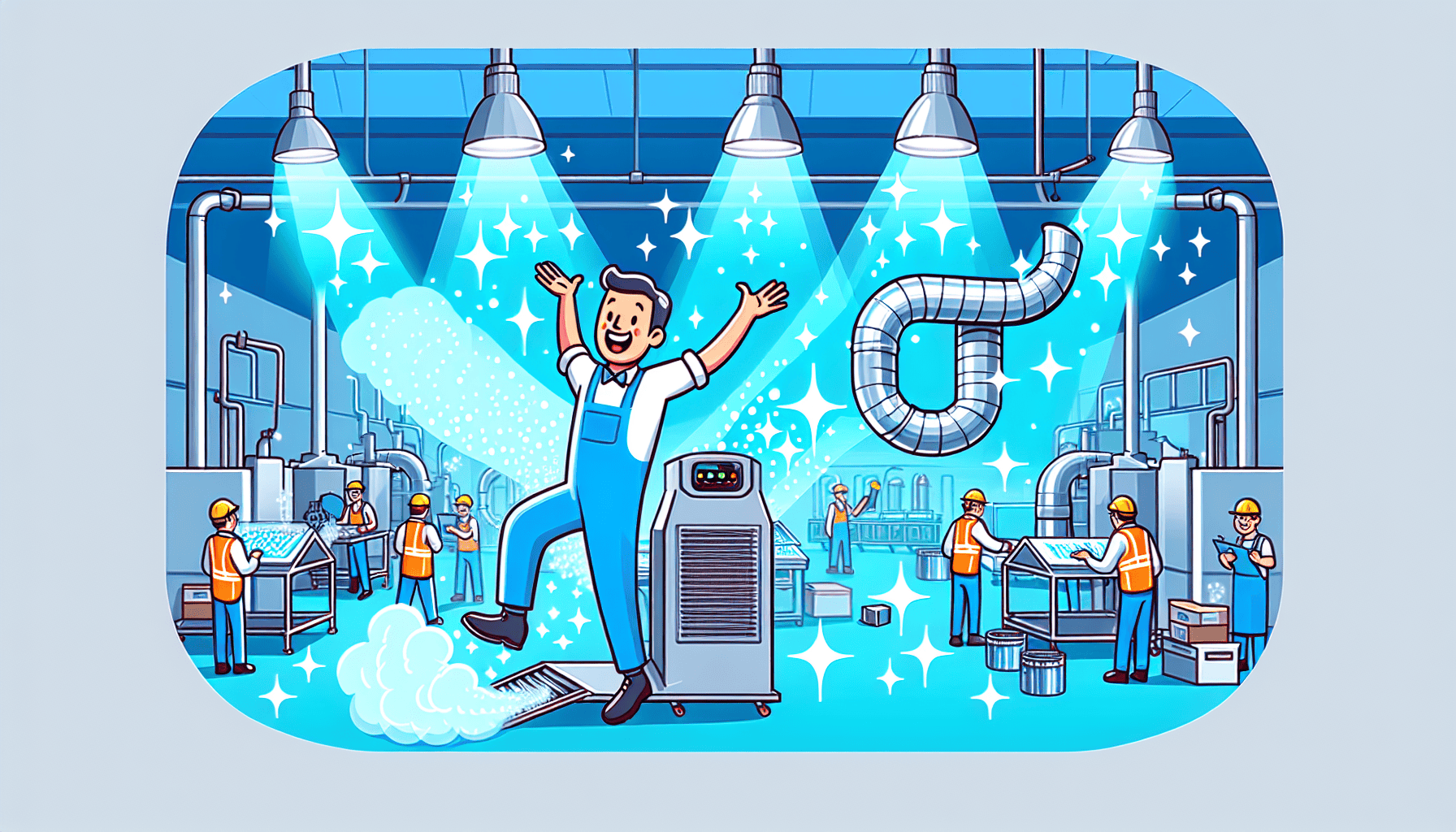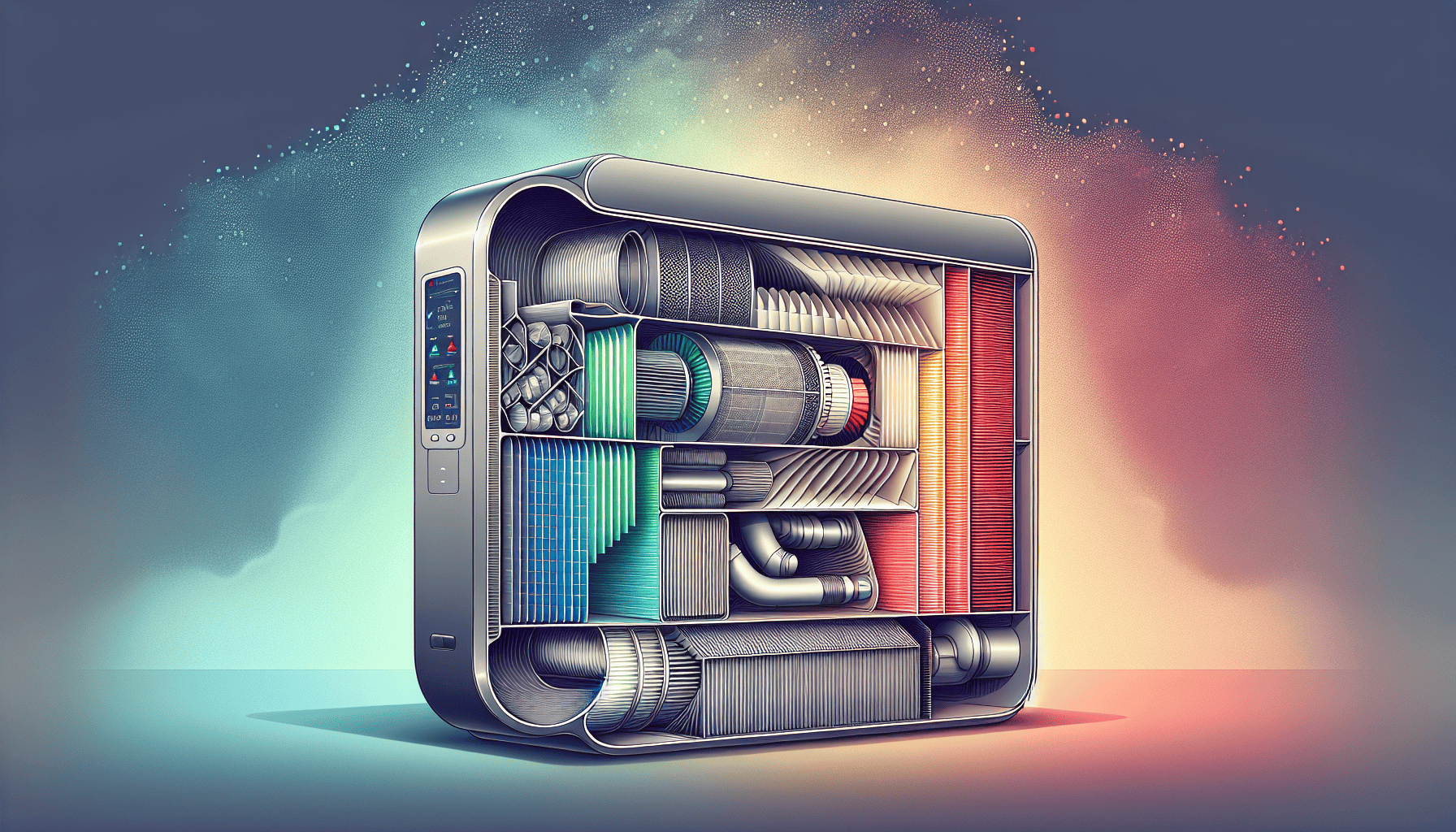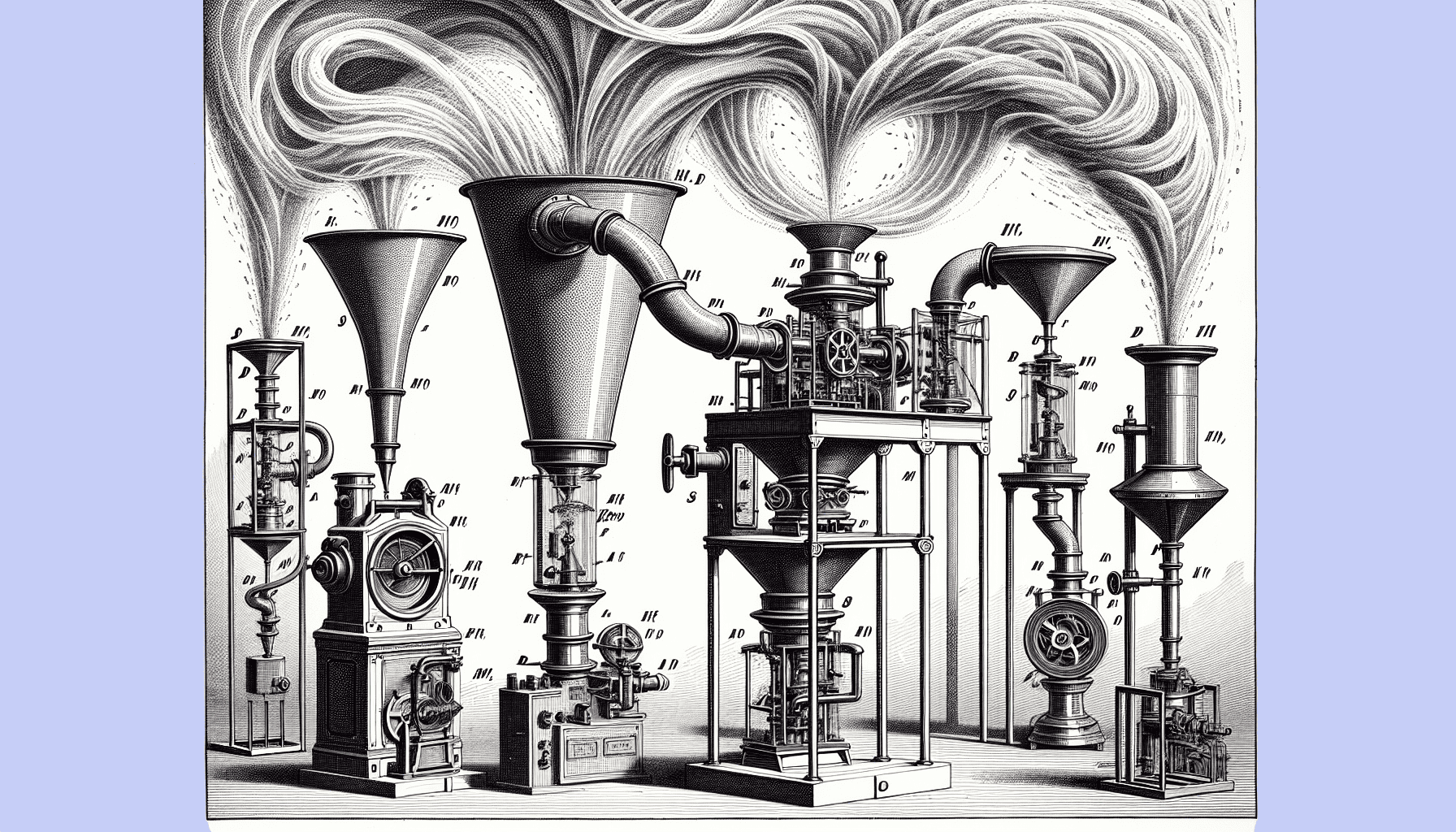Looking to boost workplace safety and nail those health standards? A mist collector is your new best friend.
These handy devices are lifesavers in industrial settings, gobbling up oil and coolant mists to keep the air fresh and machinery purring.
Dive into this article to discover everything about mist collectors—from picking the perfect one to mastering its upkeep. Let's get you on the path to a healthier, more efficient workspace!
Key Takeaways
- Want to ensure top-notch workplace safety? Grab a mist collector! These champs capture airborne contaminants and comply with OSHA standards, keeping the air clean and workers safe.
- In industrial settings, mist collectors are vital for capturing airborne contaminants right at the source. They keep the air pristine, protect machinery, and ensure compliance with health and safety regulations like OSHA.
- Want a safer, cleaner workplace? Invest in a mist collector. These devices not only safeguard your workers by filtering harmful particles but also extend equipment life, saving you money in the long run.
- Mist collectors play a critical role in industrial environments by capturing airborne contaminants at their source. They help maintain air quality, comply with OSHA regulations, and prevent equipment damage. Effective selection and maintenance involve ensuring compatibility with machinery, efficient filtration, custom solutions, and regular upkeep.
- Ready to enhance workplace safety? Choose a high-quality mist collector today! Ensure machine compatibility, maximize filtration efficiency, and set up a maintenance routine to keep your workspace healthy and efficient.
Understanding Mist Collectors and Their Importance

Mist collectors are the gatekeepers of air quality in industrial settings, designed to capture oil mist, coolant mist, and other airborne contaminants right at the source. Their performance, measured by factors such as pressure drop, efficiency, and flow rate, is critical for maintaining a clean and safe work environment.
Embracing mist collection systems is not just about cleanliness; it’s an investment in the health and well-being of everyone in the facility. By implementing these systems, you can reclaim mist generated during various processes, ensuring a safer and cleaner environment.
Types of Mist Collectors
From the bustling floors of automotive plants to the precision-driven realm of aerospace manufacturing, oil mist and coolant mist are ubiquitous by-products that need managing. Enter the diverse array of mist collectors:
- Machine mountable units that snuggle up to the equipment
- Ceiling-hung collectors overseeing operations from above
- Standalone devices that stand guard, filtering a wide array of industrial coolants
Each model is designed with specific industrial processes in mind, ensuring that whether the coolant is oil-based, synthetic, or water-based, it’s handled efficiently. With water-soluble coolants being a popular choice, mist collectors can cater to a wide range of needs.
The decision to select the appropriate mist collector model should align with the specific needs of the machinery and the types of coolants in use. A mismatch can lead to suboptimal mist collection, while the right fit can be a game-changer for both performance and air quality.
The Necessity of Mist Collection Systems
Mist collectors play a significant role beyond just keeping equipment and workspaces clean. These systems are a linchpin in complying with health and safety regulations, such as those enforced by organizations like OSHA, which aim to limit exposure to metalworking fluids. By reducing airborne contaminants, mist collectors help protect workers from the myriad of health issues associated with prolonged exposure to metalworking fluids.
Also, mist collectors play a key role in maintaining machine efficiency. They keep bacteria growth in check within coolant systems, preventing the deterioration that could spell the end for motor pump seals and other vital components. It’s clear that the benefits of embracing mist collection systems are manifold, touching on every aspect of industrial operations from regulatory compliance to equipment longevity.
Key Benefits of Investing in a High-Quality Mist Collector

An investment in a high-quality mist collector signifies a commitment to workplace quality, more than just a purchase. Such systems significantly enhance indoor air quality by:
- Trapping and eliminating harmful airborne particles, including oil mist and smoke
- Leading to a healthier work environment
- Boasting high filtration efficiency and longer maintenance intervals
- Ensuring a seamless flow of clean air
- Reducing operational costs
Enhanced Worker Safety
In the fast-paced world of manufacturing, safety is paramount. High-performance mist collectors serve as a shield, protecting workers from the array of health risks associated with exposure to oil mist — from skin and eye irritation to respiratory issues and even certain cancers. The installation of these systems is a proactive step toward a more secure work environment, one that not only improves air quality but also enhances worker satisfaction and performance.
Thanks to advanced multi-stage filtration systems, modern mist collectors are incredibly effective at capturing even the tiniest oil mist particles, substantially elevating workplace safety. The significant role mist collectors play in safeguarding employee health cannot be emphasized enough.
Extended Equipment Life
Beyond just air purification, mist collectors offer the following benefits:
- Safeguard CNC machines from the harmful effects of oil mist
- Filter out oil and coolant mist to prevent buildup and damage to equipment
- Tackle the primary causes of corrosion and wear head-on
- Ensure machinery continues to operate at peak performance for as long as possible
The implications of this extended equipment life are profound, resulting in significant cost savings over time. With mist collectors in place, the longevity of valuable CNC machines is no longer left to chance.
Compliance with Occupational Safety and Government Regulations
Mist collectors are integral to compliance with health and safety standards, aiding companies in meeting the strict regulations set by organizations like OSHA. By controlling exposure to metalworking fluids, these systems ensure that companies can confidently meet the permissible limits of oil mist exposure, thus avoiding costly penalties and protecting their workforce.
Industrial hygienists, the professionals who assess workplace air quality, rely on mist collectors to maintain safe levels of airborne contaminants, ensuring that operations stay within regulatory bounds.
Selecting the Right Mist Collector for Your Needs

The process of selecting the perfect mist collector for your facility involves considering factors such as:
- Machine tool compatibility
- Filtration efficiency
- Maintenance needs
- Capacity to offer custom solutions for distinct challenges
Whether it’s a bustling CNC lathe or a precision milling machine, finding a mist collector that meshes with the specific needs of your equipment is essential for optimal air quality and performance.
Machine Tool Compatibility
The details are paramount when integrating a CNC mist collector. It’s essential to consider how the collector will synergize with your machine tools, taking into account factors like type, size, and the specific demands of wet machining operations. Machine tool stands that attach directly to the equipment can be a space-efficient solution, especially in environments where floor space is a premium.
CNC machines such as lathes, milling machines, and even laser and plasma cutters all radiate different amounts and types of mist, requiring tailored mist collector designs. These collectors must be adaptable to various spatial challenges within workspace environments, ensuring that they complement the machines they serve.
Filtration Efficiency and Maintenance
Filtration capabilities form the core of a mist collector. Capture efficiency, pressure drop, and flow rate are the benchmarks of performance that ensure your workspace remains free from oil mist and smoke. Maintenance is also a key factor, with cartridge mist collectors offering streamlined procedures through periodic replacement of the cartridge, as indicated by the differential pressure gauge.
Balancing the need for effective oil mist control with maintenance demands can lead to significant cost savings, reducing expenses related to replacement parts and technician service visits. Whether you opt for washable filters, which offer cost savings on replacements but require more maintenance, or disposable filters for their ease of upkeep, your choice will impact the overall efficiency and maintenance costs.
Custom Solutions for Unique Challenges
Each machining operation is unique, with its own set of challenges and demands. This is where customizable features in mist collectors shine, offering solutions tailored to the specific needs of various wet machining operations. Some benefits of using a mist collector include:
- Creating a cleaner workspace by reducing hazards associated with oil on shop surfaces
- Improving air quality by removing harmful mist and particulates from the air
- Extending the life of equipment by preventing build-up of oil and coolant
- Reducing maintenance and cleaning time
By investing in the right mist collector for your specific machining operation, you can improve efficiency, safety, and overall productivity.
Companies have the flexibility to choose from solutions like the Filtermist oil mist collectors, which offer compatibility with a wide array of machine tool brands and efficiently collect oil.
Innovative Features of Modern Mist Collectors

Engineered with multi-stage filtration, advanced filter media, and smart controls, modern mist collectors efficiently handle a wide range of airborne contaminants. These features not only promote a healthier work environment but also enhance overall air quality and safety, particularly in machine shops where operations like:
- milling
- grinding
- drilling
- turning
are commonplace.
There Are 3 Types of Mist Collector
There are 3 types of Mist Collector:
- Centrifugal Mist Collectors: These were originally made for nuclear submarine gearboxes. Centrifugal mist collectors can be mounted on top of machining centers. Its rotating filter system helps trap fine mist droplets and turns them into larger droplets.
- Cartridge Mist Collectors: Cartridge mist collectors come equipped with a high efficiency particulate air filter, also called a HEPA filter. The HEPA filter can remove industrial smoke and oil mist from the air. They come with a fan or blower that forcibly draws the mist into the cartridge filter.
- Electrostatic Precipitator Mist Collectors. These mist collectors use high-voltage electricity to charge oil droplets and smoke. Once charged, these contaminants can be pulled out of circulation by passing them between charged plates. This causes the hazardous materials to stick to the plate and removed from airflow.
Advanced Filter Media and Final Filters
Advanced filter media are at the forefront of modern mist collection technology, capturing fine mist particles and ensuring the release of clean air back into the environment. Synteq XP media, for instance, represents a breakthrough in filter technology, maximizing filtration efficiency and longevity through its innovative design. Final filters, including HEPA-rated options, can capture up to 99.97% of mist and smoke, even particles as small as 0.3 microns.
Industrial settings often deal with mist droplets that are 20 microns or smaller, with oil-based fluids producing even finer droplets and oily smoke. The meticulous design of modern filter media ensures that these tiny particles are captured, maintaining clean air standards and proper air flow in even the most challenging environments. As a result, filtered air is consistently achieved, promoting a healthier workspace.
Smart Controls and Automation
The integration of automation and smart technology in mist collectors is a game-changer, enhancing adaptability to different operational conditions and simplifying maintenance requirements. This forward-thinking approach allows for systems that not only maintain clean air but do so with minimal human intervention, paving the way for greater efficiency and reliability in industrial settings.
Installation and Mounting Options for Maximum Effectiveness

Efficient installation and mounting are key to maximizing the effectiveness of mist collectors. Options range from machine mountable units to floor stands and wall brackets, catering to the diverse needs of various workspaces.
Specialized mounting solutions also play a part in ensuring that collectors are optimally positioned, regardless of the spatial constraints they might face.
Direct Mounting Benefits
Directly mounting mist collectors provides numerous benefits, including:
- Eliminating the need for bulky ductwork and support structures
- Cutting down on installation costs, both in terms of labor and materials required
- Efficient air quality management without the additional spatial demands typically associated with mist collector installation
The popularity of this method is evident in facilities seeking these advantages.
However, it’s crucial to ensure that direct mounting does not impede access for machine maintenance and operation. Proper management of machine doors and enclosures is essential to maintain a balance between accessibility and the efficiency of the mist collection process.
Versatility of Floor Stands and Wall Brackets
Floor stands and wall brackets provide a versatile installation solution for facilities needing more flexibility.
Floor stands:
- Designed to accommodate open-top machines like vertical machining centers
- Ensure stability and prevent tipping during operation
- Come with an extendable design for easy transportation and height adjustments
- Have a pre-drilled base plate for secure anchoring to the workshop floor
Wall brackets, on the other hand, are compatible with all mist collector models and provide a space-saving alternative by affixing the units to walls or I-beams.
Specialty Mounting Solutions
Sometimes, traditional mounting options simply won’t fit the bill, and that’s where specialty mounting solutions come into play. Horizontal inlet plenums, for example, enable mist collectors to be mounted at a lower height, making them more accessible for service and maintenance when direct mounting isn’t feasible.
Machine tool stands offer another flexible option, allowing mist collectors to be directly attached to the machine tool, thus conserving valuable floor space while keeping the unit within easy reach for upkeep. The Royal Filtermist plenum exemplifies this adaptability, with a side intake designed for locations where space constraints limit mist collector positioning.
Maintenance and Upkeep: Ensuring Long-Term Performance
The lifespan and functionality of mist collectors hinge on their proper maintenance and upkeep. High-quality models can reduce the need for frequent maintenance, thereby minimizing downtime and keeping CNC machine shops running smoothly.
Regular inspection, cleaning, and timely replacement of parts are the cornerstones of a well-maintained mist collection system.
Routine Inspection and Cleaning
Maintaining the high performance of mist collectors requires a proactive maintenance schedule. Regular checks of motor bearings, cleaning or replacing filters, and ensuring that the system operates at peak efficiency are critical tasks.
For collectors with washable filters, a six-month maintenance schedule is recommended, regardless of usage. Additionally, maintaining an inventory of essential parts such as ionizer wires and motor assemblies can prevent extended downtimes due to unexpected failures.
Replacement Filters and Parts
An ample supply of replacement filters and parts is necessary to ensure the uninterrupted functioning of your mist collectors. Key components like:
- pre-filters
- primary filters
- HEPA filters
- essential parts such as fasteners and seals
should always be on hand. When filters show signs of decreased performance or an uptick in particulate emissions, it’s a clear signal that replacements are needed.
Regular reviews and updates to the parts inventory are good practices to prevent potential operational delays.
Summary
Throughout this exploration, it’s become clear that mist collectors are not just beneficial but essential components of modern industrial workspaces. Their ability to enhance air quality, safeguard worker health, extend equipment life, and ensure regulatory compliance makes them invaluable allies in the pursuit of efficiency and safety. With the right selection, installation, and maintenance, these systems can be the cornerstone of a clean, productive, and safe working environment.
Frequently Asked Questions
What are the main types of contaminants that mist collectors filter out?
Mist collectors filter out oil mist, coolant mist, and other particles produced during industrial processes such as machining and grinding, ensuring clean air in the workspace.
How often should mist collector filters be replaced?
Mist collector filters should be replaced periodically, following the manufacturer's guidelines or the indications of a differential pressure gauge. For washable filters, a maintenance and cleaning schedule every six months is typically advised.
Can mist collectors be customized for specific applications?
Yes, mist collectors can be customized for specific applications by selecting appropriate filters, adjusting the collector for the amount of mist generated, and integrating with various machine tools, providing a solution that fits the specific application.
Are there smart controls and automation features available in modern mist collectors?
Yes, modern mist collectors often incorporate automation and smart technology, allowing for efficient operation and consistent air quality. This reduces maintenance requirements and adapts to changing conditions.
What are the benefits of direct mounting mist collectors?
Direct mounting mist collectors offer reduced installation costs, are space-efficient, and have become popular in facilities where managing air quality without sacrificing floor space is important. Proper management of machine doors and enclosures is essential for maintaining accessibility for machine maintenance and operation.
Be the first to know about updates at CNC Cookbook
Join our newsletter to get updates on what's next at CNC Cookbook.